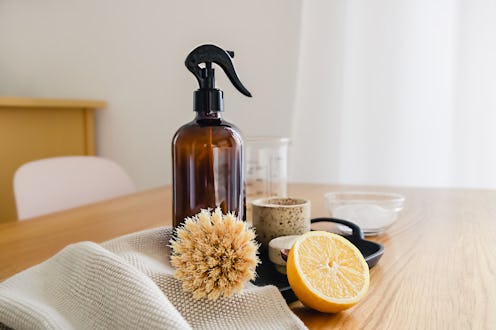(Home)
The Major Difference Between Vinegar & Bleach Is Crucial To Know Right Now
One is definitely superior to the other.

The past 18 months have given many a newfound appreciation (and understanding) of a truly clean home. Buzz words like “disinfecting” and “sanitizing” has likely entered your vocabulary like never before, and with good reason. In addition to getting spots and stains out of countertops and surfaces, it seems most are also concerned about wiping out bacteria and viruses from their homes, which might mean rethinking the old cleaning formulas that once worked fine. In particular, vinegar as a natural solution has been called into question. How does vinegar actually compare to chemicals like bleach? Unfortunately, experts say the differences between the two are more significant than one would think.
Read more: How To Make Apple Cider Vinegar Taste Good If You Hate The Flavor But Want The Benefits
“Simply speaking, vinegar is nowhere near as effective as bleach, and ... it does not wipe out as many germs,” says Adil Bhaloda, Clinical Lead and Pharmacist at Prescription Doctor. “Of course, vinegar does eliminate some things, but it’s important to note it’s not a complete solution to disinfectant. It is only 90% effective against bacteria and around 80 percent effective against viruses and mold or mildew. Bleach, however, eliminates 99.9% of bacteria, viruses, and mold or mildew. This information can easily be looked up at the health department.”
Indeed, according to the United States Environmental Protection Agency (EPA), vinegar is not a registered disinfectant against COVID-19, while bleach certainly is. “If you need to disinfect (or sanitize), bleach is a much better choice than vinegar,” says Dr. Samantha Radford, a former human toxicology professor who currently runs science- and health-focused parenting blog Evidenced-Based Mommy.
While the two solutions obviously don’t go hand in hand, it’s possible for them to both serve separate purposes in your home cleaning routine. Vinegar can be used to clean household surfaces as well items like coffee pots, dishwashers, shower doors, bathtubs, rug stains, and clothes. “It helps remove oil residues, mineral buildup from hard water, soap residue, and stains caused by food and wine,” explains Dr. Maria Vila, DO, a family medicine specialist in Morristown, New Jersey and medical advisor for eMediHealth. “The important thing about vinegar is that it doesn't release fumes that can irritate your eyes and lungs and it is not toxic.”
For disinfecting purposes, however, bleach is the winning choice. “Bleach can be used directly or in a diluted form mixed with water to help clean surfaces,” says Dr. Vila. “Some of the surfaces bleach can be used to clean include countertops in kitchens, bathtubs, toilets, and of course, stains on white clothing. Remember that it releases fumes which can be irritating to the eyes, lungs and to your skin, so use gloves and make sure the area is well ventilated.”
According to the Department of Health's guidance on the use of bleach, if it contains 5.25 percent sodium hypochlorite it should be diluted as follows: “[A ratio of] 1:99 diluted household bleach (mixing 10ml of bleach with one liter of water) can be used for general household cleaning.” The department also advises that disinfected surfaces and articles be rinsed with water and wiped dry.
While in many cases, joining two powerful forces can be a good thing, that’s not the case with vinegar and bleach. “Although both vinegar and bleach are good cleaning solutions that most people have at home, you should never mix them,” says Dr. Vila. “Mixed chlorine gas will be released which is harmful and irritating.”
If you think you’re showing symptoms of coronavirus, which include fever, shortness of breath, and cough, call your doctor before going to get tested. If you’re anxious about the virus’s spread in your community, visit the CDC for up-to-date information and resources, or seek out mental health support.
This article was originally published on